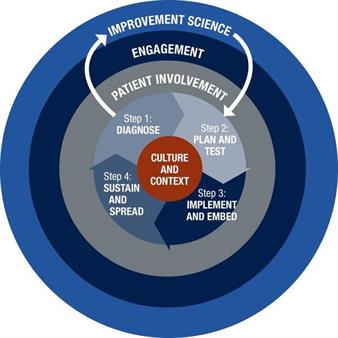AKI and Quality Improvement
There is evidence that current mechanisms for improving safety and quality
do not realise their full potential,
for example,
Audit and significant event analysis as part of Annual NHS appraisals.
There is a recognised need for quality improvement activities to help:
Address system factors impacting on patient safety
Aggregate data to encourage learning and improvement within and across organisations
Involve patients and carers
By focusing on AKI as a lens through which we can shift away from a single disease framework
and improve patient safety for patients, the opportunity arises to drive quality improvements in:
medical safety
safer transitions of care
safety for vulnerable patients.
Principles underpinning AKI Quality Improvement
Addressing a major NHS priority, the RCGP Quality Improvement Project aims to be an exemplar
of how to embed improvement methods in routine practice and provide a platform to realise the Triple Aim.
The project aims to provide an example of how to improve patient safety in primary care
and across the interfaces of care.
In doing so, it hopes to mitigate safety risks that are common to multiple problems beyond AKI.
Key principles underpinning AKI Improvement work are:
Develop evidence based interventions grounded in an in-depth understanding of routine clinical practice
Navigate the challenge of overdiagnosis:
Maximise clinical utility of AKI as a driver of quality and safety
whilst minimise treatment burden for patients
(and corresponding unnecessary clinician workload)
Support system resilience through person-centred collaborative working across the interfaces of care
Approaches to Quality Improvement
This section outlines two complementary approaches to supporting improvement in everyday clinical practice:
The QI Wheel for Primary Care
There is evidence that current mechanisms for improving safety and quality
do not realise their full potential,
for example,
Audit and significant event analysis as part of Annual NHS appraisals.
There is a recognised need for quality improvement activities to help:
Address system factors impacting on patient safety
Aggregate data to encourage learning and improvement within and across organisations
Involve patients and carers
By focusing on AKI as a lens through which we can shift away from a single disease framework
and improve patient safety for patients, the opportunity arises to drive quality improvements in:
medical safety
safer transitions of care
safety for vulnerable patients.
Principles underpinning AKI Quality Improvement
Addressing a major NHS priority, the RCGP Quality Improvement Project aims to be an exemplar
of how to embed improvement methods in routine practice and provide a platform to realise the Triple Aim.
The project aims to provide an example of how to improve patient safety in primary care
and across the interfaces of care.
In doing so, it hopes to mitigate safety risks that are common to multiple problems beyond AKI.
Key principles underpinning AKI Improvement work are:
Develop evidence based interventions grounded in an in-depth understanding of routine clinical practice
Navigate the challenge of overdiagnosis:
Maximise clinical utility of AKI as a driver of quality and safety
whilst minimise treatment burden for patients
(and corresponding unnecessary clinician workload)
Support system resilience through person-centred collaborative working across the interfaces of care
Approaches to Quality Improvement
This section outlines two complementary approaches to supporting improvement in everyday clinical practice:
The QI Wheel for Primary Care

Informed by Institute for Healthcare Improvement methodology,
The RCGP has developed the Quality Improvement Guide for General Practice.
Key resources include:
Process Mapping - creates a visual representation of a process enabling waste and areas for improvement to be identified
Fishbone diagram - used to identify the root causes of a problem (also called a cause and effect diagram)
Model for Improvement and PDSA (Plan Do Study Act) - proposes three questions to ask prior to testing a change using a PDSA cycle
Systems Thinking for Everyday Work (STEW)
The RCGP has developed the Quality Improvement Guide for General Practice.
Key resources include:
Process Mapping - creates a visual representation of a process enabling waste and areas for improvement to be identified
Fishbone diagram - used to identify the root causes of a problem (also called a cause and effect diagram)
Model for Improvement and PDSA (Plan Do Study Act) - proposes three questions to ask prior to testing a change using a PDSA cycle
Systems Thinking for Everyday Work (STEW)
.jpg)
The ‘Systems Thinking for Everyday Work (STEW)’ approach embraces a Safety-II perspective
and is informed by the principles laid out in the white paper written by the European Organisation for the Safety of Air Navigation.
A Safety-II perspective emphasises that healthcare organisations
‘might improve their ability to learn from past experience by studying not only what goes wrong (i.e. represented by incidents),
but also by considering what goes right (i.e. by learning from everyday clinical work).'
The STEW principles act as a framework for teams to explore everyday work
by obtaining multiple perspectives to understand how and why people adapt their ways of working
to cope with the system conditions they face (such as competing goals or availability of information).
AKI Safety Template 1 is designed to support case note review of patients who have generated an AKI Warning Stage Test Result in primary care
AKI Safety Template 2 is designed to support case note review of patients who have had a hospital admission complicated by AKI
AKI Safety Template 3 is designed to aid reflection and learning through a summary of cases
in order to create action plans for practice-level improvements in future care.
AKI Shared Learning from case note reviews – a summary of the key learning points and suggested actions for improvement
and is informed by the principles laid out in the white paper written by the European Organisation for the Safety of Air Navigation.
A Safety-II perspective emphasises that healthcare organisations
‘might improve their ability to learn from past experience by studying not only what goes wrong (i.e. represented by incidents),
but also by considering what goes right (i.e. by learning from everyday clinical work).'
The STEW principles act as a framework for teams to explore everyday work
by obtaining multiple perspectives to understand how and why people adapt their ways of working
to cope with the system conditions they face (such as competing goals or availability of information).
AKI Safety Template 1 is designed to support case note review of patients who have generated an AKI Warning Stage Test Result in primary care
AKI Safety Template 2 is designed to support case note review of patients who have had a hospital admission complicated by AKI
AKI Safety Template 3 is designed to aid reflection and learning through a summary of cases
in order to create action plans for practice-level improvements in future care.
AKI Shared Learning from case note reviews – a summary of the key learning points and suggested actions for improvement

